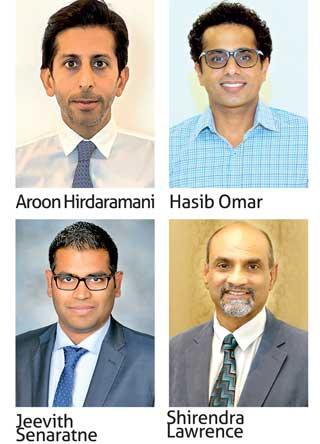Reply To:
Name - Reply Comment
Leaders of Sri Lanka’s apparel sector highlighted the industry’s prioritisation of employee safety through the adoption of and adherence to comprehensive health measures, while ensuring business continuity and thereby the industry’s sustenance.
 These views were expressed at a recent virtual webinar organised by the American Chamber of Commerce (AMCHAM) in Sri Lanka on the theme ‘The pandemic resilient corporate success of Sri Lanka’s apparel industry’.
These views were expressed at a recent virtual webinar organised by the American Chamber of Commerce (AMCHAM) in Sri Lanka on the theme ‘The pandemic resilient corporate success of Sri Lanka’s apparel industry’.
The event featured Hirdaramani Group Director Aroon Hirdaramani, MAS Holdings Executive Director Shirendra Lawrence, Brandix Group’s subsidiary Moose Clothing Company Executive Director Hasib Omar and Star Garments Group Senior Manager and Business Analysis Jeevith Senaratne. It was moderated by AMCHAM Sri Lanka President Presantha Jayamaha.
Speaking at the event, the four leaders representing some of the industry’s biggest players assured that while more than 90 percent employees have been partially vaccinated and 70 percent have been fully vaccinated, companies are going above and beyond in adhering to the health and safety guidelines, seeking to provide the maximum possible protection to employees.
“We’ve had to physically alter the production floors, establish social distancing protocols, implement health checks and remote working arrangements wherever possible. The discipline of adhering to these protocols was also established and monitoring systems have been put in place,” Lawrence said.
“Even though 70 percent of the workforce is fully vaccinated, the industry continues to maintain strict protocols such as social distancing, screening, random PCR testing and other COVID-19 prevention health and safety guidelines that are issued by the Health Ministry,” Omar added.
The apparel industry leaders acknowledged the government and health authorities for their contribution in vaccinating the employees and the Joint Apparel Associations Forum (JAAF) in advocating for vaccination of all employees.
While prioritising employee safety, the industry has to also focus on economic sustainability, to avoid dismantling the relationships that have been built over decades. These are critical to the future of the sector, which accounts for almost half the country’s export earnings. It employs 350,000 individuals directly and has created 700,000 indirect jobs and contributes 6 percent of the country’s gross domestic product (GDP), they noted.
“Industry leaders had to focus on balancing the economic sustainability of our organisations while giving top priority to the safety and protection of our employees, whose job roles require them to function from the factories,” Lawrence said.
“We have to compete against global and regional competitors, if we are to retain the relationships that we’ve worked very hard to establish over the last 20 to 30 years. Some of these competitors may not be experiencing the same challenges we have at the present time, so it is not a level playing field.”
Despite significant order cancellations due to the pandemic, industry leaders said that the impact would have been more severe, if it hadn’t been for the strategic relationships that the industry established with buyers and the reputation it had earned as an ethical, sustainable, innovative and high-value supplier.
“Sri Lanka’s apparel industry has been built mostly on strategic customer relationships and partnerships, rather than on transactional order placements,” said Hirdaramani.
“These partnerships were very much tested by the pandemic and the resulting mass order cancellations. However, given the industry’s strategic partnerships, most buyers acted in that spirit of partnership; the discussions on solutions to issues were consultative and there were comprises on both sides.”
In addition, industry leaders also pointed out that proactive actions and technology adoption by the sector ensured business continuity.
“The pandemic accelerated the adoption of technology, which existed but which was underutilised. The prime example of this is 3D product development technology, using which we were able to produce samples virtually, get comments in real-time and execute, without having to produce physical samples, which was difficult, given the circumstances. In our company, we have increased the share of 3D product development usage from 15 percent pre-pandemic to 50 percent, in our business,” Senaratne said.
Omar of Brandix shared his company’s experience of commencing the production of personal protective equipment (PPE) by initially configuring its existing machinery and obtaining approval for face mask exports amidst the constraints posed by the pandemic. That, he said indicated the Sri Lankan apparel sector’s adaptability and resilience.